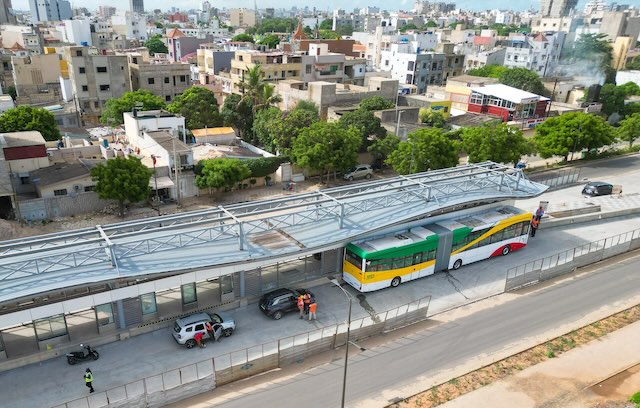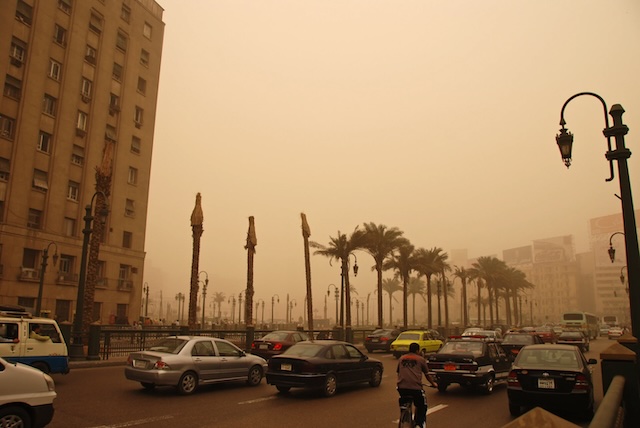The World Bank is promoting bus-rapid transit as “green” and “sustainable transportation” that is “faster and cheaper to build than Metros,” meaning heavy rail. When operated with all-electric buses, says the agency, BRT will “cut life-threatening air pollutants” as well as greenhouse gas emissions.
A bus-rapid transit station in Dakar, Senegal. Photo courtesy of CETUD.
The World Bank is absolutely correct about the faster and cheaper part. However, it is overpromising when it comes to taking cars off the road. “Developing country cities that have not yet fully developed their land use and transportation infrastructure around cars can leapfrog car-centered culture and prioritize efficient, low-carbon urban transport that focuses on people rather than vehicles,” says a World Bank official. This is pure rhetoric that consigns developing cities to economic stagnation.
Don’t forget that many major cities in the developed world, including New York, Chicago, St. Louis, London, and Paris were optimally designed for walking and transit when the first low-cost automobiles appeared. Residents of those cities didn’t say, “We don’t need cars when we have such excellent transit systems.” Instead, the majority bought cars and drive for most of their travel. Inner-city populations declined and mobility increased as both jobs and residents moved to the suburbs in large numbers.
People were right to buy cars. Even in the New York urban area, the most transit-intensive region of the United States, the average resident can reach about as many jobs in a 20-minute auto trip as a 40-minute transit trip and four to fourteen times as many jobs by auto as by transit in trips of the same length of time. There is no ideal combination of urban design and urban transit that will grant people as much mobility as they can enjoy with an automobile.
Yet this affirms the use of bus-rapid transit over rail transit in developing cities. Such cities are bound to undergo dramatic changes in transportation patterns as new job centers open up, people move to new residential areas, and transportation technologies change. This means it is short-sighted to saddle such cities with the high cost of rail systems that aren’t likely to connect most residents with jobs a few years from now.
However, when transportation officials talk about “taking cars off the road” or, worse, preventing them from ever owning cars, they are effectively relegating large numbers of urban residents to poverty. The automobile is a key to reducing poverty, and if it has negative effects on air quality or climate, it would be better to treat those emissions than to try to discourage driving.
Air pollution in Cario, Egypt. Photo courtesy of Kim Eun Yeul/World Bank.
The World Bank report is accompanied by the above photo of air pollution in Cairo, Egypt. Such images were common in the United States 50 years ago but are rare today thanks to emissions control technologies that have reduced toxic emissions from highway vehicles by 90 percent despite a tripling of miles of driving since 1970. Some cars emit so little air pollution that the Environmental Protection Agency classifies them as “super ultra low emissions vehicles” because the produce 90 percent less emissions than the average new car, which in turn is 90 percent cleaner than the average car of 53 years ago.
So trying to get people to drive less isn’t the only way to reduce emissions. The World Bank wants to encourage electric buses to reduce greenhouse gas emissions, but that only works if the electricity is generated in ways that don’t emit greenhouse gases. To the extent that it is, electric cars can do the same thing and more fuel-efficient cars can reduce emissions even if the electrical generation plants are powered by fossil fuels.
In short, the World Bank is right to see bus-rapid transit as a superior substitute for rail transit. It is wrong to see it as a superior substitute for auto driving. Most residents of developing countries probably already know that automobiles provide them with better mobility, so the goal should be to make automobiles cleaner and greener, not to try to deny people access to that mobility.










The capital inputs of cars to make them “Greener” , no just Less polluting. I’m not anti-car. but peak Outputs of what we can accomplish without downgrading engine size, we can have Much cleaner and fuel efficient cars if we downscale engine displacement and horsepower for efficiency. But average vehicle weights have increased, There’s almost no vehicle on US roads weighing less 3000 lbs.
In the 1980s, as China launched its pivotal economic reforms, eight out of every 10 Beijingers used bicycles as their primary mode of transport and the capital city had some of the world’s best bike lanes. Beijing was known as the “bicycle kingdom”. Now it’s air quality is thick enough to slurp with a straw.
https://images.seattletimes.com/wp-content/uploads/2023/03/urnpublicidap.org0772282676f440876ac4f008383d0ddbChina_Air_Quality_61733.jpg?d=780×520
Bicycles themselves are a mature technology with not that much to improve upon since geared bike was invented in 1880s. They don’t need rails, overhead lines, traffic management systems, traffic lights, smart grids, smart phone aps, gas stations, batteries or superconductors, charging ports, digital doodads, computerized whatcha callems; they Help, but they aren’t necessary. They require none of those things except a flat surface.
The EV bike takes most/all the sweat equity out of transportation outdoors. Factor in fuel, insurance, registry, parking and maintenance, urban EV bicycling saves 3-4 thousand dollars a year.
EV’s, propane/LNG powered buses, hybrid bus, etc, are band-aids but excellent mitigators for pollution like particulates and smog, not CO2.
While ago I said how micro turbines would revolutionize energy industry and possibly disrupt electric market.
47% US homes use natural gas heating. Gas energy density of 0.29 kw-h per cubic foot, the US residential sector uses 16% or 5.1 trillion cubic feet. With a brayton cycle turbine efficiency; US homes have potential to produce literally 55,000 MW power or 12% US electric consumption.
“ Such images were common in the United States 50 years ago but are rare today thanks to emissions control technologies that have reduced toxic emissions from highway vehicles by 90 percent despite a tripling of miles of driving since 1970” (Antiplanner)
Anyone who doubts that should be shown this:
https://www.epa.gov/air-trends/air-quality-national-summary (1980-2022)
…and this…
https://www.epa.gov/sites/default/files/2021-05/epa-banner-images/2020_baby_graphic_1970-2020.png (1970-2020)
Of course EPA credits “ federal and state implementation of stationary and mobile source regulations” for the stunning progress but, have no doubt, at the end of the day it was vehicle buyers and owners who paid the price.
Milan follows Paris in condemning their citizens to poverty:
https://www.wantedinmilan.com/news/italy-milan-to-ban-cars-from-city-centre-2024.html
outside of the us, i guess i mean western Europe in particular, Germany, Netherlands…with vastly superior transit systems and expenditure…and i assume greater transit usage in metro areas? is poverty relatively stable there?
”
Milan follows Paris in condemning their citizens to poverty:
” ~janeH
You’re probably saying that tongue in cheek. Do not; it’s literally true. With a few small exceptions like Luxembourg, all the nations of Europe are more poor than Mississippi.